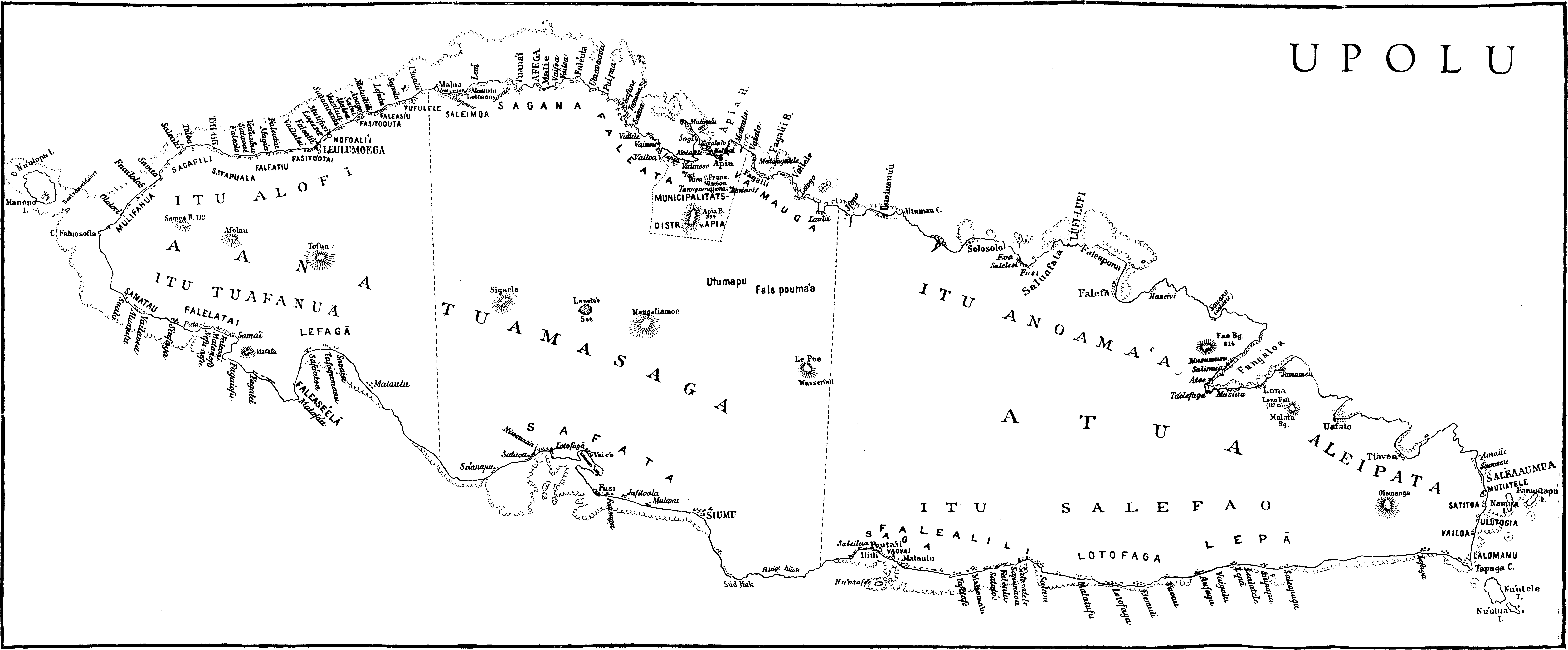|
Malie
Malie is a village on the island of Upolu in Samoa. It is located on the north coast in the Electoral Constituency (''Faipule District'') of Sagaga Le Usoga which forms part of the larger political district of Tuamasaga. The village has been a traditional headquarters for the Malietoa, one of the four paramount families and royal titles of Samoa. The village has a population of 2247. Geography Malie's western border lies by the western bay at Vaifoa, next to Fale'ula. Between the two villages is the promontory Satea. Another five minutes further west and inland lies Malie itself with its large malae, on which lies the large stone tomb of Malietoa Molī, father of Malietoa Laupepa. Immediately adjacent is Lalau, forming Malie's boundary. Tuamasaga As part of Tuamasaga Tuamāsaga is a district of Samoa, with a population (2016 Census) of 95,907. The geographic area of Tuamasaga covers the central part of Upolu island. History & Politics Malie & the Malietoa The paramount ' ... [...More Info...] [...Related Items...] OR: [Wikipedia] [Google] [Baidu] |
Malietoa
Mālietoa ( ''Mālietoa'') is a state dynasty and one of the four paramount chiefly titles of Samoa. It is the titular head of one of the two great royal families of Samoa: Sā Malietoa. Literally translated as "great warrior", the title's origin comes from the final words of the Tongan warriors as they were fleeing on the beach to their boats, "Malie To`a, Malo e tau..." ("Great warrior, thank you for the war). The title is currently held by His Highness Malietoa Fa’amausili Molī, who was bestowed the honor in Malie on 16 August 2018, ascending to the title after the death of his father, His Highness Malietoa Tanumafili II on 11 May 2007. History In early Polynesian history Tongan king Tu'i Tonga Talakaifaiki of the Tu'i Tonga dynasty ruled, around 1250 to 1300, over several western Polynesian polities including Lau Islands, Lau group of islands (eastern Fiji), Niue, 'Uvea, Futuna Island, Wallis and Futuna, Futuna, 'Upolu, and Savai'i). Tu'i Tonga Talakaifaiki established a ... [...More Info...] [...Related Items...] OR: [Wikipedia] [Google] [Baidu] |
Malietoa Tanumafili I
Susuga Malietoa Tanumafili I (1879 – 5 July 1939) was the Malietoa in Samoa from 1898 until his death in 1939. Personal and political life Tanumafili was born in 1880 to Malietoa Laupepa and Sisavai‘i Malupo Niuva‘ai. He attended the London Missionary College in Malua, before continuing his education in Fiji.Last King of Samoa ''Pacific Islands Monthly'', August 1939, p29 He married Momoe Lupeuluiva Meleiseā and had five children: Sisavai‘i Lupeuluiva, Vaimo‘oi'a, Salamāsina, Tanumafili II, and Sāveaali‘i Ioane Viliamu. When his father died in 1898, Tanumafili was declared "King of Samoa" (Tafa'ifa) by William Lea Chambers, and recognised by Germany, the United Kingdom an ... [...More Info...] [...Related Items...] OR: [Wikipedia] [Google] [Baidu] |
Tuamasaga
Tuamāsaga is a district of Samoa, with a population (2016 Census) of 95,907. The geographic area of Tuamasaga covers the central part of Upolu Upolu is an island in Samoa, formed by a massive basaltic shield volcano which rises from the seafloor of the western Pacific Ocean. The island is long and in area, making it the second largest of the Samoan Islands by area. With approxim ... island. History & Politics Malie & the Malietoa The paramount ''matai'' title of Tuamasaga is the Malietoa title. Led by Auimatagi, Sa Malietoa and the nine senior orators of Malie are responsible for the election of the Malietoa title-holder at Niu'ula in Malie. Given that the district of Aiga-i-le-Tai ( Manono and Apolima) and the district of Fa'asaleleaga on Savai'i are two key footholds of the Aiga Sa Malietoa (Malietoa clan), Malie often consults with Manono (capital of Aiga-i-le-Tai) and Safotulafai (capital of Fa’asaleleaga) in the election of the Malietoa. The village o ... [...More Info...] [...Related Items...] OR: [Wikipedia] [Google] [Baidu] |
Samoa
Samoa, officially the Independent State of Samoa; sm, Sāmoa, and until 1997 known as Western Samoa, is a Polynesian island country consisting of two main islands (Savai'i and Upolu); two smaller, inhabited islands (Manono Island, Manono and Apolima); and several smaller, uninhabited islands, including the Aleipata Islands (Nu'utele, Nu'ulua, Fanuatapu and Namua). Samoa is located west of American Samoa, northeast of Tonga (closest foreign country), northeast of Fiji, east of Wallis and Futuna, southeast of Tuvalu, south of Tokelau, southwest of Hawaii, and northwest of Niue. The capital city is Apia. The Lapita culture, Lapita people discovered and settled the Samoan Islands around 3,500 years ago. They developed a Samoan language and Samoan culture, Samoan cultural identity. Samoa is a Unitary state, unitary Parliamentary system, parliamentary democracy with 11 Administrative divisions of Samoa, administrative divisions. It is a sovereign state and a member of the ... [...More Info...] [...Related Items...] OR: [Wikipedia] [Google] [Baidu] |
Upolu
Upolu is an island in Samoa, formed by a massive basaltic shield volcano which rises from the seafloor of the western Pacific Ocean. The island is long and in area, making it the second largest of the Samoan Islands by area. With approximately 145,000 inhabitants, it is by far the most populous of the Samoan Islands. Upolu is situated to the southeast of Savai'i, the "big island". Apia, the capital, is in the middle of the north coast, and Faleolo International Airport is at the western end of the island. The island has not had any historically recorded eruptions, although there is evidence of three lava flows, dating back only to between a few hundred and a few thousand years ago. In the Samoan branch of Polynesian mythology, Upolu was the first woman on the island. James Michener based his character Bloody Mary in '' Tales of the South Pacific'' (later a major character in the Rodgers and Hammerstein musical, ''South Pacific'') on the owner of Aggie Grey's Hotel ... [...More Info...] [...Related Items...] OR: [Wikipedia] [Google] [Baidu] |



